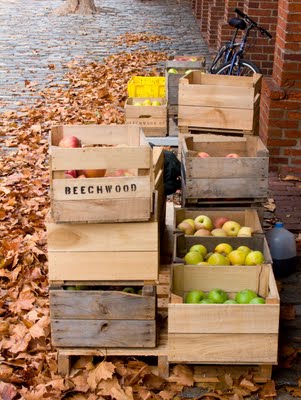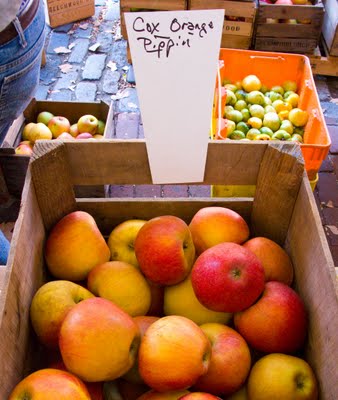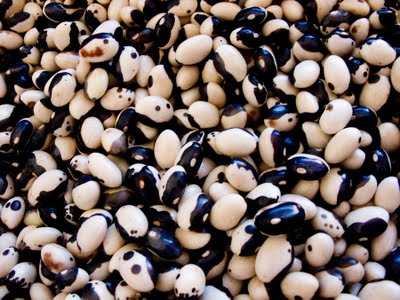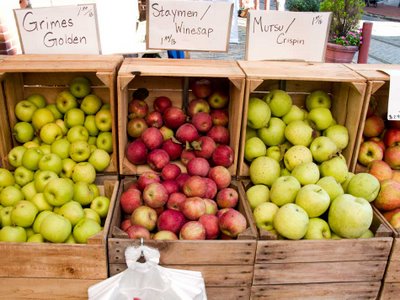Tuesday, February 23, 2010
In early December at the Headhouse Square Farmers' Market Beechwood Orchards featured Newtown Pippin apples, a variety that dates to the early 1700s, first found in what is now the New York City borough of Queens.
It is regarded as one of the great storage apples, i.e., it improves with age. And February is regarded as the peak month for its eating. So the other day I pulled one out of the fruit bin of my fridge (stored in a plastic bag with plenty of air holes).
It was superb, and a contradiction of complex flavors: sweet and tart, crisp and tender. It's an apple with depth. Much superior to when I tasted it immediately after purchase. And it stored beautifully, with no soft spots or blemishes beyond those present when picked.
I'll be sure to lay in a supply again next December.
Labels: apples, beechwood orchards, headhouse square, newtown pippin
Sunday, November 22, 2009
Dave Garretson of Beechwood Orchards, who sells at the Headhouse Square Farmers' Market, loves his apples, and this week he had one of the best, the Newtown Pippin.
This variety probably originated in the early 18th century in what is now the Elmhurst area of Queens, New York. (Take the Brooklyn-Queens Expressway and you'll cross Newtown Creek). It was beloved by Thomas Jefferson, Benjamin Franklin, and Queen Victoria.
The Newtown Pippin (unlike my favorite, the Cox Orange Pippin) is one of the great storage apples, which only gets better with age: I plan to delay the gratification of eating them until February, by which time their sugars will be fully formed and balance the tart, piney, citrusy, nutty flavor of this American classic; kept in cold storage with adequate air circulation (a perforated bag in your refrigerator's crisper), they'll probably keep until spring. Eat them now and you'll only get a glimmer of their complexity.
Today it's rare to find Newtown Pippins in the fresh market. Most are turned into juice, thanks to its clear, flavorful nature. If you've enjoyed Martinelli's sparking cider. you've consumed Newtown Pippins. Martinelli's purchases, at above market prices, have prevented the California plantings of Newtown Pippins from being uprooted in favor of other crops.
This revered variety was pushed out of the fresh market over the last 20 years by the Granny Smith, which offers only a hint of the wonders of the Newtown Pippin, but is more visually appealing than the frequently lopsided antique apple, whose countenance can appear marred because of natural russetting near the stem end.
In addition to California, the Newtown Pippin was a favored variety in tidewater Virginia, where the parochials renamed it the Albemarle Pippin, not wanting to keep the Yankee name. It was a major export item to England until the early 20th century when tariffs decimated that market.
Although the Newtown Pippin works well in pies, as well as apple sauce, it's highest uses are for cider and as a dessert (fresh eating) apple
Labels: apples, beechwood orchards, headhouse square, newtown pippin
Sunday, November 15, 2009
 Beechwood Apple Pricing
Beechwood Apple PricingDave Garretson of Beechwood Orchard, who sells at Headhouse Square, has changed his pricing system. Until this week, he priced his fruit by the pint or quart. It was always good value, but you had to take it home and weigh it out to get a good comparison with other vendors.
Starting today he switched to strict by-the-pound pricing. His apples were $2/pound, pretty much in line with other vendors.
And he's still got Cox Orange Pippins.
Dave's only fear is that he's going to have to restrain himself when picky customers threaten to bruise the fruit next peach season.
Labels: apples, beechwood orchards, headhouse square
Sunday, November 08, 2009
 Apple
Appleof My Eye
I've been telling Dave Garretson of Beechwood Orchards about Cox Orange Pippins for a couple of years now. This week he found some on a neighbor's orchard and brought them to Headhouse Square.
Although these apples were picked about a month ago and have been in storage, they've hardly lost anything. Indeed, this variety ripens best after picking. Cox Orange Pippins are only moderately crisp (those who insist on absolutely crunchy crispness will be disappointed), but their flavor is second to none, with a perfect balance of sweetness and tartness. Many believe, as I do, that it's the world's finest dessert apple, i.e., for eating uncooked. It's no wonder that Cox Orange Pippins are the most popular apple in the U.K., so much so that they're imported from South Africa in the off-season. (Alas, because they are more susceptible to disease, it's likely to lose this distinction soon, as more growers shift to other varieities.)
This variety first appeared in 1825 in England. And if you think the taste is vaguely familiar, you aren't imagining it. Today's Gala apple is a less flavorful but hardier descendant.
Labels: apples, beechwood orchards, cox orange pippin, headhouse square
Saturday, October 17, 2009
 Autumn at Headhouse
Autumn at HeadhouseThese Ying Yang dried beans from Culton Organics are just one of the many varieties of fall produce I found at Headhouse Square Farmers' Market last Sunday.
Tom also featured some delicious, though small, chestnuts. They roasted up perfectly (about 10 minutes in a 425 toaster oven; be sure to make a small 'x' on the flat side to avoid popping). Out of the first two dozen chestnuts I roasted, there were only two that were moldy/inedible.
Brussells sprouts have been making their appearance at local markets, too. Tom was selling his for $5 a quart. His white, purple or orange cauliflower and romanesco was $5 for medium-sized heads. Yellow string beans were $5/quart, sweet potatoes $2/pound. Among fruits, Tom had delicious Winter Banana apples as well as Asian pears; they were pricey at $1 apiece.
Pumpkins, as predicted in a previous post, are expensive this year. Blooming Glen's jack-o-lantern pumpkins were $8 apiece. Long Island cheese pumpkins, ideal for baking use, particularly pies, were $6 each; huge Blue Hubbard squashes were similarly priced. Butternut squash was more reasonable $1.25/pound, Delicata $1.50. Blooming Glen still had field tomatoes last Sunday for $3/pound. Potatoes, both all-purpose and small Russetts (baking) were $2/pound.
North Star Orchards' apples were all $2/pound, except the Honey Crisps, $2.50. Magness pears were $2.
Beechwood Orchards apples were $4/quart, $4.5o for Honey Crisps. Pears were $5/quart, chestnusts $6/quart.
Margarums also had potatoes, including $2/pound Russetts.
Labels: apples, beans, beechwood orchards, blooming glen, brussels sprouds, chestnuts, culton, headhouse square, north star orchards, pears, potato, produce, pumpkins, squash
Sunday, October 12, 2008

With my store of Cox Orange Pippins rapidly dwindling it's time to resupply. And, just in time, the winesaps are here. These Stayman Winesaps were offered at the Headhouse Square market today by the Wenk family's Three Springs Fruit Farm. Over at Beechwood farms they offered a variety called Turley Winesap. A quick Googling divulged that it was developed in the late 19th century in Indiana. It's apparently not quite as fine a fresh-eating (dessert) apple as the Stayman, but is very good for baked applications. It was particularly important in the early 20th century because of its storage quality and ability to be shipped by rail with little delerious effect.
Over at North Star I picked up a couple each of Golden Russet and Sugar Snap varieties.The former is another fav: a crisp, sweet, medium-sized apple that's a good keeper. So what if it's not red! I haven't tasted the Sugar Snap yet, which has a nice red inflected skin. North Star's website says it's a sweet-tart apple derived from the Empire.
What is it, precisely that separates a common apple from an antique/heirloom variety? That's a discussion I had with Sarah Cain, co-manager of the Fair Food Farmstand yesterday when I noted the sign for the Jonamac's called them heirlooms. Just by its name, I expressed my doubt that the apple qualified, because it's an intentional Jonathan-MacIntosh cross. Sarah contends that even hybrids developed by orchardists qualify fror the "heirloom" nominclature so long as they are 50 years old.
Even on that basis, however, it's hard to justify calling this cross an heirloom or antique. Although the New York State Agircultural Station in Geneva began experimenting with Jonathan-MacIntosh crosses in 1944, a final cross wasn't introduced to the commercial market until 1972, though the strain was largely developed, bred and tested since the late 1950s.
Although I've yet to fine a clear definition of what makes an an apple an "heirloom" or an "antique," my readings suggest that to most people, they mean a variety of apple that was developed introduced prior to the mass shipping by rail of apples in the early 20th century. Apples like the Jonamac, which were developed by government-funded entities after World War II, clearly don't qualify.
An excellent account of the search for heirloom apples under this definition can be found in the November 2002 issue of Smithsonian magazine.
Labels: apples, farmers markets, headhouse square, winesap
 Robert's Market Report
Robert's Market Report
